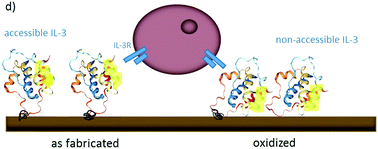当前位置:
X-MOL 学术
›
J. Mater. Chem. B
›
论文详情
Our official English website, www.x-mol.net, welcomes your
feedback! (Note: you will need to create a separate account there.)
Switchable presentation of cytokines on electroactive polypyrrole surfaces for hematopoietic stem and progenitor cells†
Journal of Materials Chemistry B ( IF 6.1 ) Pub Date : 2018-07-02 00:00:00 , DOI: 10.1039/c8tb00782a Johanna Baumgartner 1, 2, 3, 4 , Jan-Ingvar Jönsson 3, 4, 5 , Edwin W. H. Jager 1, 2, 3, 4
Journal of Materials Chemistry B ( IF 6.1 ) Pub Date : 2018-07-02 00:00:00 , DOI: 10.1039/c8tb00782a Johanna Baumgartner 1, 2, 3, 4 , Jan-Ingvar Jönsson 3, 4, 5 , Edwin W. H. Jager 1, 2, 3, 4
Affiliation

|
Hematopoietic stem cells are used in transplantations for patients with hematologic malignancies. Scarce sources require efficient strategies of expansion, including polymeric biomaterials mimicking architectures of bone marrow tissue. Tissue microenvironment and mode of cytokine presentation strongly influence cell fate. Although several cytokines with different functions as soluble or membrane-bound mediators have already been identified, their precise roles have not yet been clarified. A need exists for in vitro systems that mimic the in vivo situation to enable such studies. One way is to establish surfaces mimicking physiological presentation using protein-immobilization onto polymer films. However these films merely provide a static presentation of the immobilized proteins. It would be advantageous to also dynamically change protein presentation and functionality to better reflect the in vivo conditions. The electroactive polymer polypyrrole shows excellent biocompatibility and electrochemically alters its surface properties, becoming an interesting choice for such setups. Here, we present an in vitro system for switchable presentation of membrane-bound cytokines. We use interleukin IL-3, known to affect hematopoiesis, and show that when immobilized on polypyrrole films, IL-3 is bioavailable for the bone marrow-derived FDC-P1 progenitor cell line. Moreover, IL-3 presentation can be successfully altered by changing the redox state of the film, in turn influencing FDC-P1 cell viability. This novel in vitro system provides a valuable tool for stimuli-responsive switchable protein presentation allowing the dissection of relevant mediators in stem and progenitor cell behavior.
中文翻译:

造血干细胞和祖细胞在电活性聚吡咯表面上细胞因子的可转换显示†
造血干细胞用于患有血液系统恶性肿瘤的患者的移植。稀缺资源需要有效的扩展策略,包括模仿骨髓组织结构的高分子生物材料。组织微环境和细胞因子呈递方式强烈影响细胞命运。尽管已经鉴定出几种具有不同功能的细胞因子作为可溶性或膜结合介体,但其确切作用尚未阐明。需要模仿体内的体外系统进行此类研究的情况。一种方法是使用蛋白质固定在聚合物膜上来建立模仿生理学表现的表面。然而,这些膜仅提供了固定蛋白的静态展示。动态地改变蛋白质的呈递和功能以更好地反映体内条件将是有利的。电活性聚合物聚吡咯具有出色的生物相容性,并通过电化学方式改变了其表面性能,成为此类装置的一个有趣的选择。在这里,我们介绍一个体外膜结合细胞因子的可转换呈递系统。我们使用白细胞介素IL-3(已知会影响造血作用),并显示当固定在聚吡咯膜上时,IL-3可用于骨髓来源的FDC-P1祖细胞系。此外,可以通过改变膜的氧化还原状态来成功改变IL-3呈递状态,进而影响FDC-P1细胞的生存能力。这种新颖的体外系统为刺激反应的可转换蛋白呈递提供了一种有价值的工具,可以解剖干细胞和祖细胞行为中的相关介体。
更新日期:2018-07-02
中文翻译:

造血干细胞和祖细胞在电活性聚吡咯表面上细胞因子的可转换显示†
造血干细胞用于患有血液系统恶性肿瘤的患者的移植。稀缺资源需要有效的扩展策略,包括模仿骨髓组织结构的高分子生物材料。组织微环境和细胞因子呈递方式强烈影响细胞命运。尽管已经鉴定出几种具有不同功能的细胞因子作为可溶性或膜结合介体,但其确切作用尚未阐明。需要模仿体内的体外系统进行此类研究的情况。一种方法是使用蛋白质固定在聚合物膜上来建立模仿生理学表现的表面。然而,这些膜仅提供了固定蛋白的静态展示。动态地改变蛋白质的呈递和功能以更好地反映体内条件将是有利的。电活性聚合物聚吡咯具有出色的生物相容性,并通过电化学方式改变了其表面性能,成为此类装置的一个有趣的选择。在这里,我们介绍一个体外膜结合细胞因子的可转换呈递系统。我们使用白细胞介素IL-3(已知会影响造血作用),并显示当固定在聚吡咯膜上时,IL-3可用于骨髓来源的FDC-P1祖细胞系。此外,可以通过改变膜的氧化还原状态来成功改变IL-3呈递状态,进而影响FDC-P1细胞的生存能力。这种新颖的体外系统为刺激反应的可转换蛋白呈递提供了一种有价值的工具,可以解剖干细胞和祖细胞行为中的相关介体。











































 京公网安备 11010802027423号
京公网安备 11010802027423号